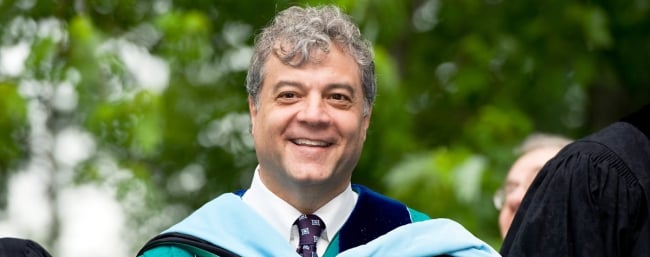You have /5 articles left.
Sign up for a free account or log in.

Mark Scheinberg must retire as president of Goodwin University and trustee of the University of Bridgeport within five years.
Goodwin University
Mark Scheinberg is a man of many responsibilities—president of Goodwin University, trustee at the University of Bridgeport and owner of two small for-profit colleges: Stone Academy and the Paier College of Art. Now a Department of Justice settlement will force him out of all three roles.
For years Scheinberg paid back students’ loans to hide his colleges’ cohort default rate from the Department of Education, according to a settlement with the Department of Justice made public May 27.
The Fallout
Between 2015 and 2019, Scheinberg made 154 payments from himself and Stone Academy via money order to loan servicers on behalf of 102 Stone Academy students. His goal was to prevent the students from falling into default, which would have raised the college’s cohort default rate—the share of federal loan borrowers who default within a certain time period—according to details from the Department of Justice.
Scheinberg paid out $1 million as part of the settlement, which also requires him to retire from his posts at Goodwin University and the University of Bridgeport within five years.
Additionally, Scheinberg has “entered into an administrative agreement with the Department of Education in which Scheinberg agreed to cease involvement and participation in the operations, and divest direct ownership” of both Stone Academy and Paier College of Art.
“The cohort default rate is an important metric that students can use to research whether a school provides a valuable education, because it can show whether the degree they would earn will help them find employment that allows them to stay current on their student loans,” Vanessa Roberts Avery, U.S. attorney for the District of Connecticut, said in a statement. “Educational institutions—especially private, for-profit schools—that attempt to hide high student loan default rates from the Education Department and their students not only risk forfeiting their and their students’ eligibility to receive federal funds, but they risk federal enforcement by our office and our investigative agency partners.”
Stone Academy, which has three separate campuses in Connecticut, has a 15 percent default rate, according to the most recent College Scorecard data from the Department of Education. That's more than twice the national average default rate of 7.3 percent in 2018.
Goodwin University did not respond to Inside Higher Ed's request for comment, but Scheinberg provided a statement to the Journal Inquirer, a local newspaper, acknowledging making the payments was a mistake.
The statement said that although the increase in Stone Academy's default rate would have been "immaterial," he accepted the settlement to "put the dispute behind" him. "At 66 years old with much yet to accomplish, I have chosen to devote my remaining educational career to the important work that brings joy to my life—creating new opportunities that students with diverse talents and backgrounds can use to succeed,” Scheinberg told the newspaper.
A spokesperson told the Journal Inquirer that Scheinberg’s retirement is not imminent. Scheinberg founded Goodwin in 1999, and has been its only president. Goodwin acquired the nonprofit University of Bridgeport in 2021. Though Bridgeport has a separate administration and president, Scheinberg serves as a trustee.
Reaction to the Settlement
Kevin Kinser, department head of education policy studies and a professor and senior scientist of education at Pennsylvania State University, said it’s unclear how common the retirement and divestment conditions of the settlement are, but it makes sense, given accreditation standards, that a board would want leadership “untainted by regulatory concerns.” He added that five years seemed like a long off-ramp for Scheinberg’s retirement.
“Not sure why, if the president’s tenure as a leader was untenable, why the board would wait to end the relationship. I wonder also whether the timeframe was affected by an accreditation review, for example, the President needed to be gone before the next accreditation review,” Kinser wrote by email.
Jonathan Glater, a law professor and faculty director of the Center for Consumer Law & Economic Justice at the University of California, Berkeley, School of Law, said that while he hasn’t heard of a scheme where college owners paid student loans, it’s hardly shocking given what’s at stake.
“I’ve not heard of this particular tactic before, but I am not that surprised because of the importance of the cohort default rate. The kind of scheme prosecutors describe here shows the importance of oversight in the federal student aid system, to protect individual borrowers,” Glater wrote by email.
Noted critics of for-profit colleges were more pointed.
“Gaming accountability metrics has been common practice in the for-profit college sector for more than a decade,” Mike Pierce, executive director of the Student Borrower Protection Center, said by email. “Ten years ago next month, a Senate investigation highlighted how the largest for-profit schools worked to evade Cohort Default Rate metrics by hiring shady consultants to call former students and push them to pause their loan payments rather than fall behind. For these borrowers, interest keeps accruing making their debt more expensive, but colleges are spared the consequences of a loan default.”








